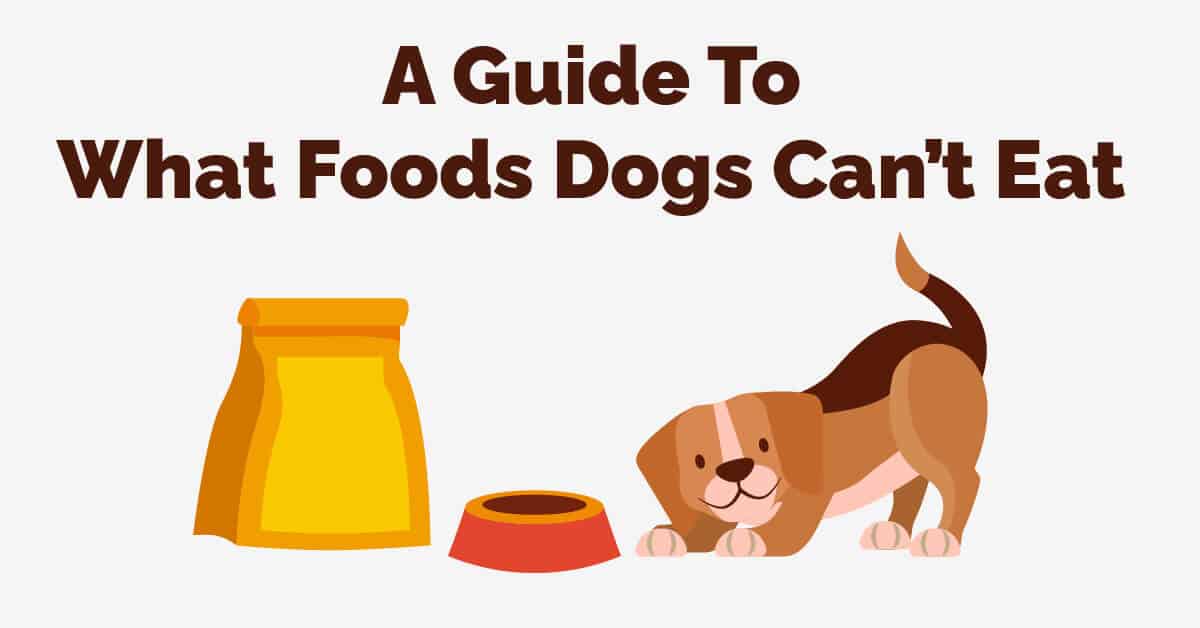
Learn about the different types of food that are not safe for dogs to eat so you can keep your furry friends safe.
Introduction

It’s safe to say that dogs become a part of the family from the moment they step paw through the front door, so of course, we want to do everything we can to keep them safe.
Anyone who has a furry family member of their own would probably agree that it’s also safe to say that your dog will eat pretty much anything they can get their paws on, regardless of whether or not it’s actually safe. Even taste can’t always deter the most determined dogs!
Besides, who can honestly resist feeding their dog little bits of food under the table at dinner time? With those puppy dog eyes? If you’re anything like me, then you don’t stand a chance.
That’s why it’s so important to make sure that you have a comprehensive understanding of what dogs can and can’t eat. This way, you can make sure to keep anything and everything that is not safe for your dog to eat locked away somewhere well out of their paws’ reach.
Luckily for you, we went ahead and did all of the research for you and we’ve compiled our findings in this article; a comprehensive guide to what foods dogs can’t and shouldn’t eat.
We’ll walk you through which foods are off limits and why, as well as some of the common side effects and health issues that can occur if your dog does accidentally eat any of them.
Chocolate

Let’s kick things off with chocolate.
Chocolate is one of those foods that is meant for sharing. A nibble on a square or two with a significant other or split up between friends is perfectly fine, but this is one of many snacks that are not safe for dogs to eat, not even in small quantities or as an infrequent tasty treat.
Unfortunately, this applies to all chocolate as well. That includes white chocolate, milk chocolate, dark chocolate, orange chocolate, chili and sea salt chocolate… you name it, dog’s can’t have it. Not even chocolate flavored frosting and cake or biscuits.
Chocolate contains toxic substances that are called methylxanthines. These are “stimulants that stop a dog’s metabolic process”, according to the American Kennel Association. If eaten by dogs, it can cause seizures, irregular heart function, and in the worst case, even death.
Dark chocolate in particular can cause diarrhea and vomiting which are both common side effects that can occur after a small amount of any type of chocolate has been consumed.
So, that means you’ll need to hide any chocolate-containing snacks such as cookies and trail mix with your regular chocolate, somewhere it will be impossible for your dog to reach.
In case we need to say it, this also includes skipping your dog out when it comes to making a round of hot cocoa, as liquid chocolate is just as harmful to dogs as solid chocolate is.
Onion, Garlic, and Chives
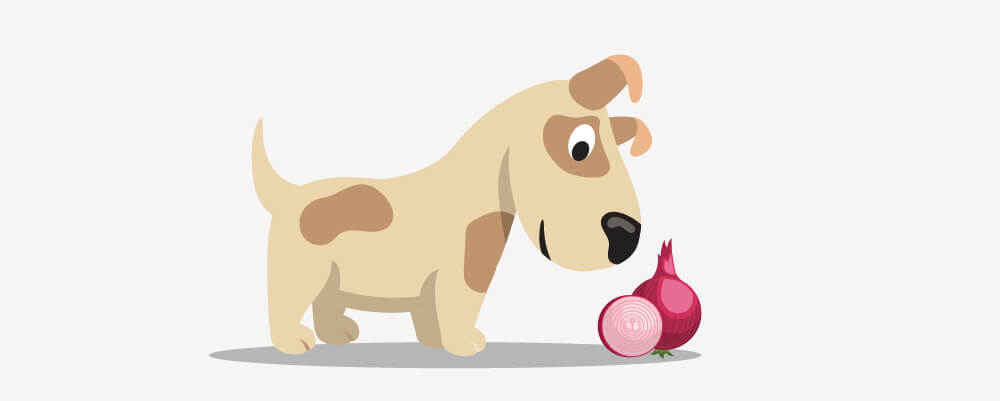
Another group of foods that are permanent residents on the “toxic for dogs” list are onion, garlic, and chives, which can all cause gastrointestinal irritation and red blood cell damage.
They are all a part of the ‘Allium’ family which means they are highly poisonous to dogs and cats alike, despite being okay for humans to eat. This is because dogs metabolize certain types of foods at a different rate than we do and will therefore have a different reaction.
It’s also due to the fact that these food items all contain something called thiosulfate, which is toxic to dogs but is perfectly fine for human consumption. This is what damages a dog’s red blood cells and can eventually lead to the development of hemolytic anemia in your dog.
So, despite the fact that there are several health benefits of garlic and onions for humans, the same can’t be the same when it comes to dogs so this is one side you shouldn’t serve.
It also means that you should try to avoid cooking with onion, garlic, chives, and any other members of the ‘Allium’ family if you’re planning on feeding the leftovers to your dog.
Symptoms to look out for in the aftermath of the chaos if your dog manages to eat any of these foods or anything containing a large amount of these ingredients includes pale mucous membranes, rapid breathing, weakness, lethargy, jaundice, and dark colored urine.
Other side effects include various signs of gastrointestinal upset, such as diarrhea, vomiting, loss of appetite, abdominal pain to severe discomfort, depression, and dehydration.
Avocado

Avocado might be the reason why millennials can’t afford to buy housing (you know, nothing at all to do with the landlords who are buying up property so they can sit back and rent it back out at inflated prices to make a profit), but your dog definitely doesn’t get the avo craze.
Avocado contains a substance called persin which can be found in its leaves, fruit, and seed, and it can cause vomiting and diarrhea if any part of this vegetable is consumed by dogs.
The seeds of an avocado can also cause further harm as they can become stuck as they pass through the intestines or stomach which could become a potentially fatal obstruction.
Sandwiches that are stuffed full of avocado are best kept in the fridge rather than on the table where your dog might be able to jump up and scarf it down, and it’s definitely a vegetable you’ll need to teach your children not to palm off to the dog under the table.
You’ll also need to be careful if you’re growing your own avocados at home in case your dog manages to get into your vegetable patch. Try to keep the area secure or supervise your dog when they’re outside to make sure they stay away from the plants to avoid any accidents.
If you do notice that your dog has managed to get their paws on one of your tasty avocados, you will need to act right away as it is not known how much of the substance persin is actually lethal. Large amounts can cause gastrointestinal issues and even pancreatitis.
Corn on the Cob

When summer time rolls around and the barbeque grills get rolled out into the sunshine, your friends, family, neighbors, and definitely your dogs all know they’re in for a good feed.
When you’re putting a separate sausage or a burger on the grill for your dog (let’s be honest, we all do it, or you know you’d just end up sharing half your food with them anyway…) you might be wondering what else is safe for your dog to eat from the other options on the grill.
Chicken is fine as long as it’s boneless (more on this later) and most meats are okay provided they are well cooked through and not raw in any places. Raw meat is dangerous for dogs as it contains bacteria that can cause food poisoning or other types of disease.
If you’ve got an eagle eye, you’ll probably have noticed that a surprisingly large amount of dog food brands include corn as a favored grain. This is because of its affordability and the fact that it can be part of a well-balanced diet for your dog due to its nutritional value.
Whilst corn itself is safe for dogs to eat, the ‘cob’ part of ‘corn on the cob’ is certainly not. If consumed by accident, the cob can cause a blockage in your dog’s intestines. Even if you think you’re being careful, a huge risk comes with sharing a corn on the cob with your dog.
Any hound who is hungry enough – and who wouldn’t be with all the other exciting smells that are wafting over from the grill – will have no trouble splintering the cob in their enthusiasm to devour the corn, which can lead to the aforementioned health issues.
If you’re concerned about any sort of corn on the cob consumption, look out for symptoms in your dog such as dehydration, lethargy, vomiting, loss of appetite and energy, and diarrhea.
Almonds

Most people could probably work out that if certain small shaped foods are a choking hazard for babies and young children, then the same could be the case for dogs as well. Just to clarify; those people are right, as almonds can block your dog’s esophagus or even tear it.
This could have major health implications for your dog, the most obvious one being an inability to breathe which can be fatal if not seen to immediately by a medical professional.
Although almonds are not necessarily as toxic to dogs in the way that macadamia nuts are, they can still cause some quite serious symptoms such as diarrhea, gas, and an upset stomach, even without the additional blockage risk that is enough to put most people off.
This can be tough around the holidays when salted nuts are a popular choice to put out in bowls for guests to pick at whenever they pop round to visit and give you their well wishes.
Salted almonds are actually among the worst types to give to your dog as these can affect your dog’s ability to retain water, increasing it to the point where it could be fatal to dogs, especially any dogs susceptible to heart disease, according to the American Kennel Club.
Artificial Sweetener (XYLITOL)
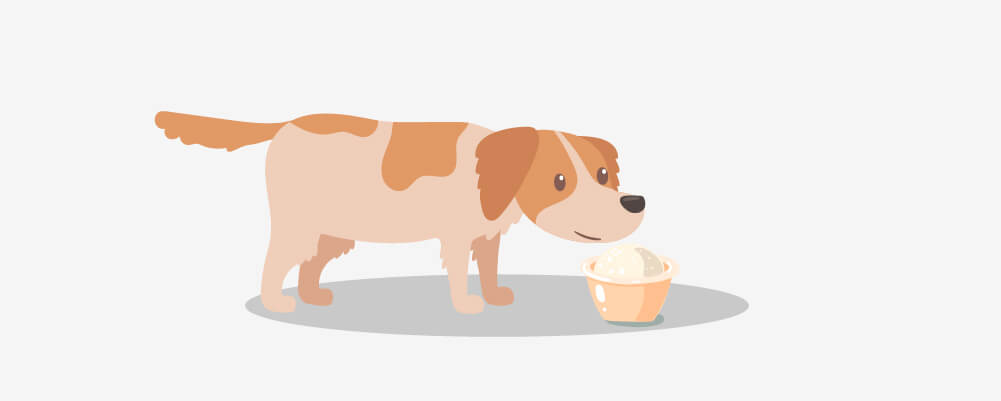
If a dog digests xylitol it can cause hypoglycemia which essentially means it can cause your dog’s blood sugar to drop which has the potential risk of leading to liver failure. Even the FDA has pronounced that Xylitol and other artificial sweeteners are dangerous for dogs.
You’ll know soon afterwards if your dog does eat anything with artificial sweeteners in it as early symptoms can include vomiting, excessive lethargy, and problems with coordination. More serious symptoms can also show up in the form of seizures and episodic fits.
In addition to making sure your dog keeps their nose out of the coffee cupboard and stays away from any artificial sweetener in its pure form, you’ll also need to be mindful about which foods contain high quantities of artificial sweeteners so that you can avoid these as well.
Yoghurt is one that has been known to catch a lot of people out, as there are some brands that have high amounts of added sugar which can spell bad news for your dog if eaten. Instead, opt for yoghurts with probiotics which can actually aid your dog’s digestive system.
There are plenty of other dangerous (and surprising) food items that contain Xylitol, so you should make sure you do some thorough research so you know what to keep out of reach.
Grapes and Raisins
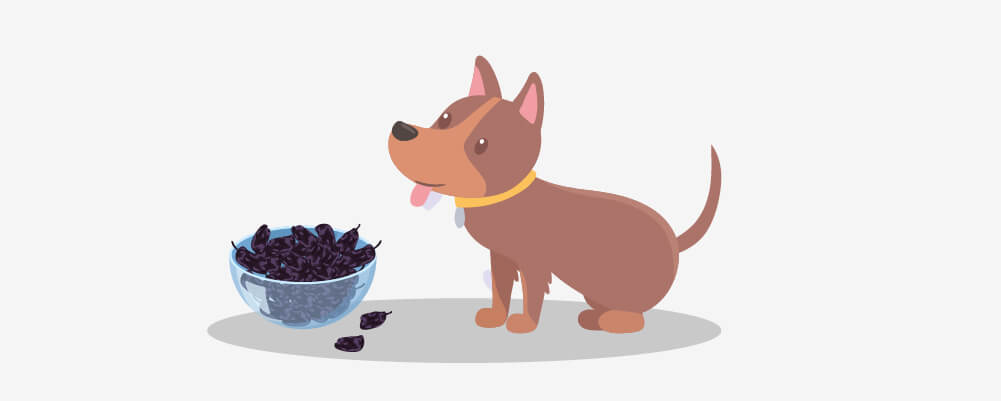
You might think that grapes and raising would make a delicious treat for your dog, filled with natural sugars and exceptionally good as a snack on a hot day after chilling in the fridge. However, you’d be wrong. There are much better alternatives to give to your dog as a treat.
You’d be right in thinking, however, that this is partly because of their small size and shape. Like almonds, grapes in particular can pose a choking hazard to the majority of dogs. But that doesn’t mean you should just cut them up into smaller, manageable bite size pieces!
Grapes and raisins are both foods that, if consumed by your dog, can actually cause health issues such as kidney failure and vomiting. I mean, raisins are just dried out, smaller versions of grapes, so it makes sense that they’re as equally bad for dogs as each other.
It doesn’t matter if they’re red, green, or purple grapes; seedless or seed still in – all grapes are toxic to dogs according to pet.md, and they should not be given to your dog at any time.
This is because grapes contain a substance that is toxic to dogs, although admittedly the source of their high toxicity has not yet been determined. However, it is precisely due to this lack of information that makes it a good idea to keep grapes and raisins away from your dog.
It also means that there is no prescriptive rulebook for when to act and after how many grapes or raisins your dog will become ill. The effects can vary between different dogs, as not all experience kidney failure despite it being one of the more serious side effects.
If your dog does accidentally eat a bunch of grapes (literally) or raisins, they will probably start to display some of the following symptoms within a short space of time:
- Loss of appetite
- Lethargy, weakness, unusual quietness or lack of activity
- Vomiting and/or diarrhea, often within a few hours of each other (good luck with that)
- Abdominal pain (you’ll know if it’s tender when touch or if your dog yelps out in pain)
- Dehydration (signs of dehydration can include panting, dry nose, dry mouth, and pale gums). You can test for this quite easily by simply scrunching the skin on your dog’s neck gently until it forms a roll and then watch to see if it springs back immediately, which is a sign that your dog is hydrated, or slowly, which suggests dehydration.
- Increased thirst and/or urine production or diminished amount of urine or complete cessation
- Kidney failure
If you notice any of these symptoms in your dog, act immediately and seek medical help.
Cooked Bones
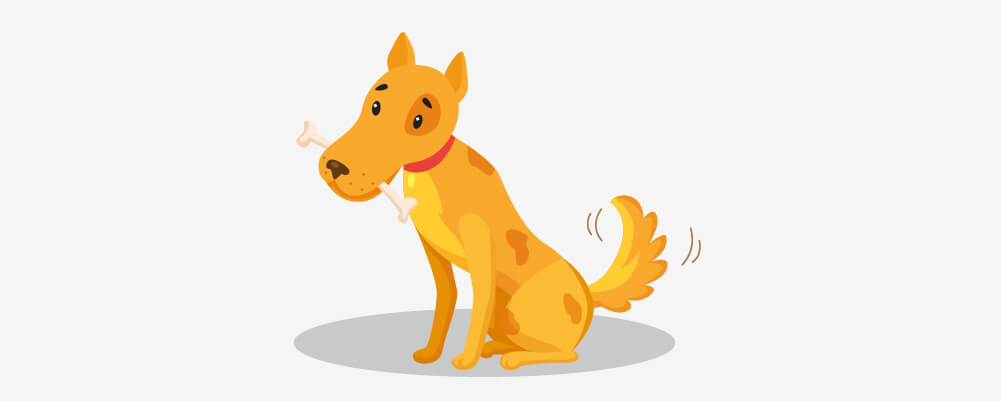
If animated movies are to be believed, the leftover bones from cooked meat carcusses are perfectly fine to throw to the dog. In real life, however, this is not the case at all.
There is even a scene in ‘The Lady and The Tramp’ where one of the Italian restaurant owners throws a bunch of bones out to the pair of dogs when they come looking for dinner, as his partner comes rushing out to chastise him, dogs deserve much better grub than this!
Cooked bones are actually dangerous for dogs, and you shouldn’t give your dog cooked bones of any kind, according to the American Kennel Club. This is because there is a risk that they could potentially splinter which can cause blockages or constipation in your dog.
According to pets.webmd you should also avoid giving your dog any of the fat trimmed from meat, both cooked and when it’s still raw, as this can potentially cause pancreatitis in dogs.
There are some ways to safely give your dog a bone to chew on, which we will detail below for those who want to use it, but I wouldn’t recommend it as there are too many potential injuries or health issues that your dog could sustain as a result of chewing on cooked bones.
You can safely give your dog bones to chew on if:
- You give them raw bones that are meant for dogs.
- You take the bone away after a 10 to 15-minute chewing session and pop it in the fridge to harden up again.
- You dispose of old bones after three or four days.
- If you have a larger breed dog, you give them larger and more appropriately sized bones.
- You don’t give your dog a bone to chew unsupervised or when you’re not home.
- You only purchase and give your dog bones that are safe for dog consumption.
Do with this information what you will, but like I said, it’s not something I would recommend. For those inclined to follow the general advice, there are plenty of dog bone alternatives.
For example, there are plenty of dog bone chew toys available or you can choose to go for something like these tasty chicken flavored rawhide dog chews for your dog to gnaw on.
Macadamia Nuts
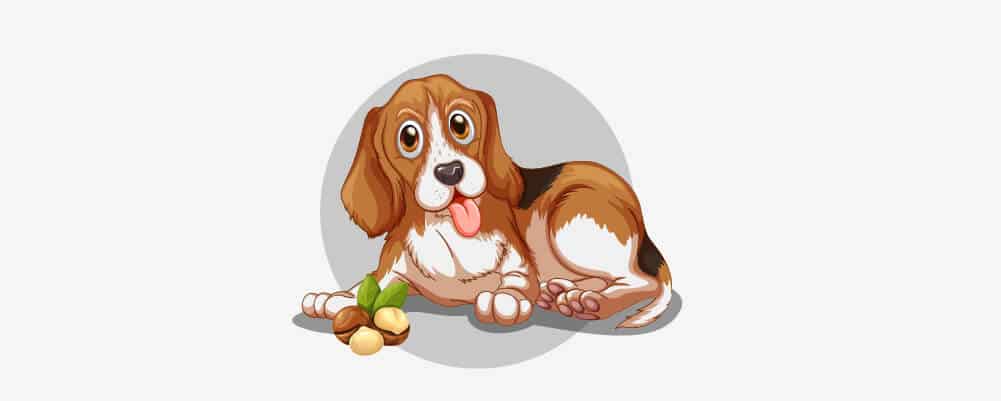
Just like almond nuts, macadamia nuts are another food that should be persistently off limits to your furry friends. These are actually some of the most poisonous foods for dogs!
According to the American Society for the Prevention of Cruelty to Animals (ASPCA), your dog “would only need to eat a small amount of food containing these nuts to experience negative results”, meaning it’s not just the nuts themselves but anything that contains them.
This is because macadamia nuts contain toxins that can affect your dog’s muscles and their nervous system. If eaten, macadamia nuts can cause negative health issues such as generally feeling weaker or experiencing depression, vomiting, tremors, and hypothermia.
Due to the high toxicity levels found in macadamia nuts, symptoms can start within just 12 hours after consumption and the minor symptoms can last for 24 to 48 hours, therefore it is best to act quickly if your dog accidentally eats any of these nuts and to call your local vets.
Some of the other more serious symptoms to look out for can sometimes include constant shaking, high fever, or difficulties walking. The high fatty content in macadamia nuts can also cause issues such as inflammation of the pancreas (or pancreatitis) after being ingested.
What to Do if Your Dog Has Eaten Any Of These Items
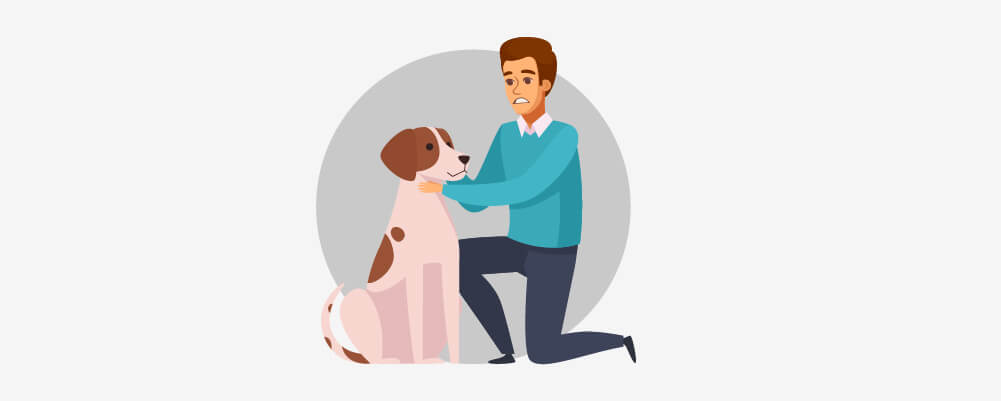
Nobody plans on allowing their dog to eat any of the foods that could potentially make them sick, but accidents happen and despite our best efforts, sometimes your dog is just going to do what your dog wants to do, and you’ll have to do your best to deal with the aftermath of it.
This is why it’s important to think about what to do if your dog has eaten any of these foods in advance of it actually happening, so that you’ll be prepared for it if it ever does. Knowing what to do and springing into action quickly could be the thing that saves your dog’s life.
So, let’s get into it.
What To Do:
First and foremost, it’s important to stay calm. If you freak out because your dog has eaten something they’re not supposed to, even though it’s completely natural to worry for them when you know that what they’ve eaten is toxic, you won’t be able to think very clearly.
This can cause you to make silly mistakes which means it takes longer to get your dog to the local vets or emergency medical center after they’ve accidentally ingested something bad.
Before you do anything, you need to find out what it is that your dog has eaten. Look out for any discarded packaging or containers that have opened or spilled. Empty wrappers or torn bits of paper are two other dead giveaways. That and the guilt all over your pup’s face.
In the event that your dog manages to get their paws on any of the foods we’ve listed in this article, always act immediately. Put your pet somewhere safe and prevent any further access to the food. Don’t worry about cleaning up for now, just contain the problem and clean later.
The number for the ASPCA Animal Poison Control Center is: (888) 426 4435, so write this down and keep it somewhere where you will easily be able to find it in an emergency. You should also make a note of the number for your local vet and the nearest emergency clinic.
Don’t delay or waste time if you suspect your dog has eaten something poisonous for dogs, and instead call for emergency help or assistance immediately. It is always always always better to be safe than sorry when it comes to our furry friends, so try to get help right away!
Even if your dog is showing no signs of symptoms at this point, it is best to seek advice.
If your dog has already started showing symptoms, a lot of people think to act quickly by trying to induce vomiting, but you should never do this before speaking to your vet and checking with them that it is okay to do so, otherwise it could cause more harm than good.
In the worst case scenario you should get your dog to the vet as quickly as possible where they will be able to assess the situation and issue the proper treatment for the toxins.
What Human Foods Are Okay for Dogs to Eat?
Despite the fact that dogs have a different digestive system from humans, there are certain types of foods that aren’t all that bad for dogs to eat and are safe for their consumption.
More than this, certain types of ‘human’ food can actually provide many nutrients and can have a number of health benefits for dogs. Here we have some of those foods in list form:
- Carrots: They might not help your dog see in the dark, but they can help remove plaque and promote good dental health in dogs. They’re also a great source of vitamin A which can be good for your dog’s skin, coat, and their immune system.
- Apples: You’ll need to keep an eye on how many, but apples provide dogs with multiple vitamins such as vitamin A and C. They also contain fiber to aid digestion.
- White rice: After it has been cooked, plain white rice can be a great option for doggy dinners, especially if your pooch has an upset stomach. White rice is easy to digest but dogs with diabetes should be aware that it can cause a rise in blood sugar levels.
- Fish: Certain types of fish are safe for dogs to eat, sucha s salmon, shrimp, and tuna. These are all great sources of protein. Salmon and tuna in particular are high in omega-3 fatty acids which can improve your dog’s immune system, coat, and skin.
- Peanut butter: We’re not talking about a BP and J sandwich here, but unsalted peanut butter that has no added sugar or sweeteners can be safe for dogs to eat. They provide dogs with vitamins A and B, niacin, and healthy fats and proteins. However, you’ll need to make sure that your dog only eats this in moderation.
- Plain popcorn: Time to hit the movies with your dog, as plain popcorn is perfectly fine for your dog to eat.
Summary

If it seems like a lot to take in all at once, it can be handy to write down or print out a smaller list of all the ingredients that are not safe for your dog to eat and keep it in your kitchen or somewhere where you can see it and refer to it if needed if ever you are unsure about food.
To recap, you cannot and should not allow your dog to eat the following foods:
- Chocolate
- Onion, garlic, and chives
- Avocado
- Corn on the cob
- Almonds
- Grapes and raisins
- Cooked bones
- Macadamia nuts
These foods and anything containing them should be kept somewhere safe where your dog cannot reach them, and you’ll need to practice getting better at resisting the puppy dog eyes they are sure to give you if they see what you’re eating. Remember, it’s for their own good!
If your dog has mastered the art of getting into your trash can to rummage through the scraps and the leftovers, it might be worth investing in a dog-proof garbage can so that even your rubbish is safe from the greedy paws and jaws of your precious pup.
You should try to make sure that you are always giving your dog a balanced diet so that they are receiving the correct amount of essential nutrients and vitamins that they need to be healthy. This way you can help them live their longest, happiest life with you.
I hope that you’ve found this article helpful and that you’re now feeling more confident that you’re clued up about which foods are not safe for dogs to eat. Avoid falling into the common trap of assuming that small quantities of the above foods will probably be fine and be vigilant about foods that contain these foods as well as each of the items individually.
If in doubt, me and my article on ‘What Dogs Can’t Eat’ still be here to refer back to!
